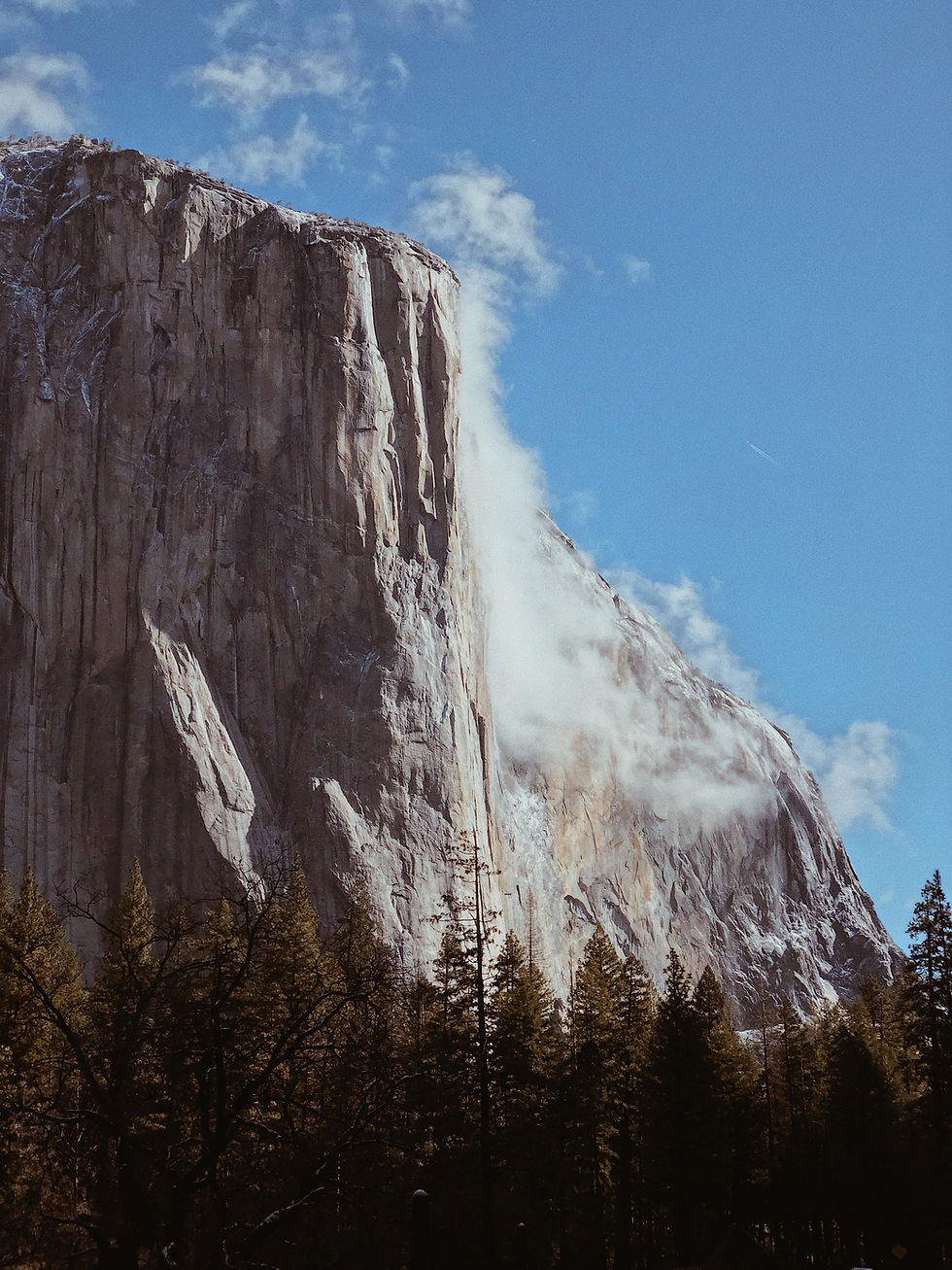Extreme Camping: Where Do Rock Climbers Sleep on Multi-Day Expeditions.
- Echo Adventure Cooperative
- Feb 1, 2024
- 4 min read
So maybe we're being a little dramatic... This climber is not sleeping 3000 feet (910m) off the ground, but he or she is attempting to climb El Capitan which stands 7069 feet (2055m) above sea level and is approximately 3000 feet (910m) from base to summit! The next question for most of us is... How!?
Rock climbing is a thrilling and adventurous sport that has captivated the hearts of outdoor enthusiasts around the world. Whether you're a seasoned climber or a beginner looking to try something new, Yosemite National Park is THE climbing destination!

Just so we are all on the same page let start with Rock Climbing 101:
Bouldering: Bouldering is a form of rock climbing that involves short, powerful climbs without the use of ropes. Climbers tackle "problems," or specific sequences of moves, on rock formations known as boulders. Yosemite National Park is home to renowned bouldering spots such as Camp 4, offering some of the most difficult problems on the books.
Sport Climbing: Often the same type of climbing you will see in a gym, sport climbing has shorter fixed routes and pre-placed bolts so you can put all of your energy into the send! Yosemite Valley is a paradise for sport climbers, boasting a variety of well-bolted routes on its famous granite walls.
Traditional (Trad) Climbing: Yosemite is synonymous with traditional climbing, and its granite cliffs provide the perfect canvas for this style of ascent. Unlike sport climbing with pre-placed bolts, Trad involves placing and then removing your own protection like nuts, chocks, and cams. This means climbers are not marring the rock surface with drills and permanent bolts. The park is home to classics like the Nose on El Capitan, a legendary trad climbing route that takes several days to complete. The long crack systems on Yosemite's El Cap offer an unparalleled trad climbing experience, requiring a combination of technical prowess and mental fortitude.

Aid Climbing: Unlike sport climbing and trad climbing that depend on the climber using his/her body to hold on to rock features to ascend, aid climbing is a form of rock climbing that uses equipment like pulleys, ladders, and hooks. Aid climbers can send a wall when there are no features to hold on to or climb.

Big Wall Climbing: This is just another term for long multi-pitch routes that take a hot minute to complete. You can aid or trad a big wall and occasionally there are pre-placed bolts, so a big wall climbing is referring to the time it takes to go very very vertical! Think the 3000 foot (910m) face of El Capitan... that's a big wall!!!

Alpine and Ice Climbing or Mountaineering: There are several other types of climbing, such as ice climbing on frozen waterfalls or glaciers, that aren't as prevalent in Yosemite National Park. Simple put, these climbers are bad ass and they really deserve there own blog!
Now that we have the different types of climbing dialed in, how do climbers survive on a multi-day trad climb!?
Sleeping on the side of vertical rock faces is a unique and challenging aspect of big wall climbing, particularly in scenarios like multi-day ascents of El Capitan. Climbers use specialized equipment and techniques to create makeshift sleeping stations, providing them with the rest they need during extended climbs.

Portaledges are the primary sleeping platforms for climbers on big walls. These are collapsible, metal-framed platforms with a durable fabric surface. They are suspended from anchors on the wall, allowing climbers to sleep comfortably in mid-air. Portaledges are compact when packed, making them easy to transport during the climb. They typically have a reinforced sleeping area, side walls for protection, and a rainfly to shield climbers from the elements. In some situations, climbers may use hanging bivouacs or "bivies" instead of full portaledges. Hanging bivies are smaller and less comfortable than portaledges, often resembling a suspended sleeping bag enclosure (WTF!). Climbers may choose hanging bivies for shorter stops during the climb when a full ledge setup is unnecessary.
Once in the portaledge or hanging bivy, climbers use specialized sleeping bags designed for vertical conditions. These bags are often narrower than traditional sleeping bags to accommodate the confines of a portaledge. Additionally, climbers may use insulating pads to provide some R value for the air circulating around them.

Setting up a sleeping station is intense and involves securing the portaledge or hanging bivy to the rock wall using a system of anchors and ropes. Climbers meticulously inspect and set up their anchors to ensure a secure and stable sleeping platform. The anchor points may include cams, nuts, and bolts placed into cracks or drilled into the rock. Climbers often establish a routine for securing themselves to the sleeping platform before settling in for the night. This may involve tying into the anchor points with a personal tether or using a harness for added safety. Climbers also secure essential gear within arm's reach in case they need it during the night.

If all that isn't enough, weather can be a significant factor when sleeping on a wall. Climbers may face exposure to rain, wind, or even extreme temperatures. The portaledge's rainfly provides some protection, but climbers must be prepared for changing conditions and have appropriate gear to stay warm and dry.
Sleeping on the side of a rock wall is not for the faint of heart, but for those who undertake big wall climbing, it's a necessary part of the adventure. The ability to rest and recharge on the wall is crucial for completing multi-day ascents, and the experience of waking up surrounded by the grandeur of a vertical landscape is an unparalleled reward for these dedicated climbers.
Have more questions!? Ask our resident Big Wall Climber!


Comentários